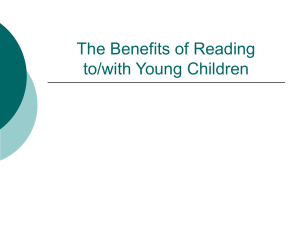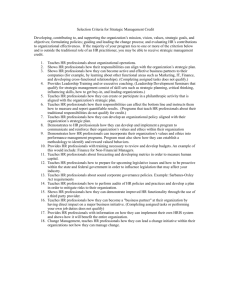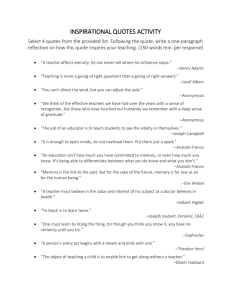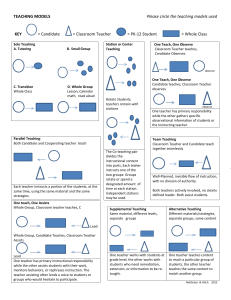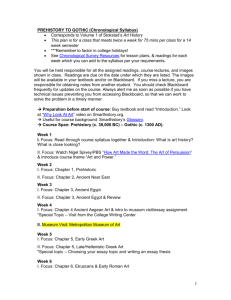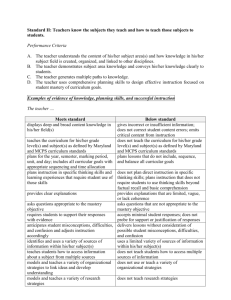AP Art History Syllabus 2010
advertisement
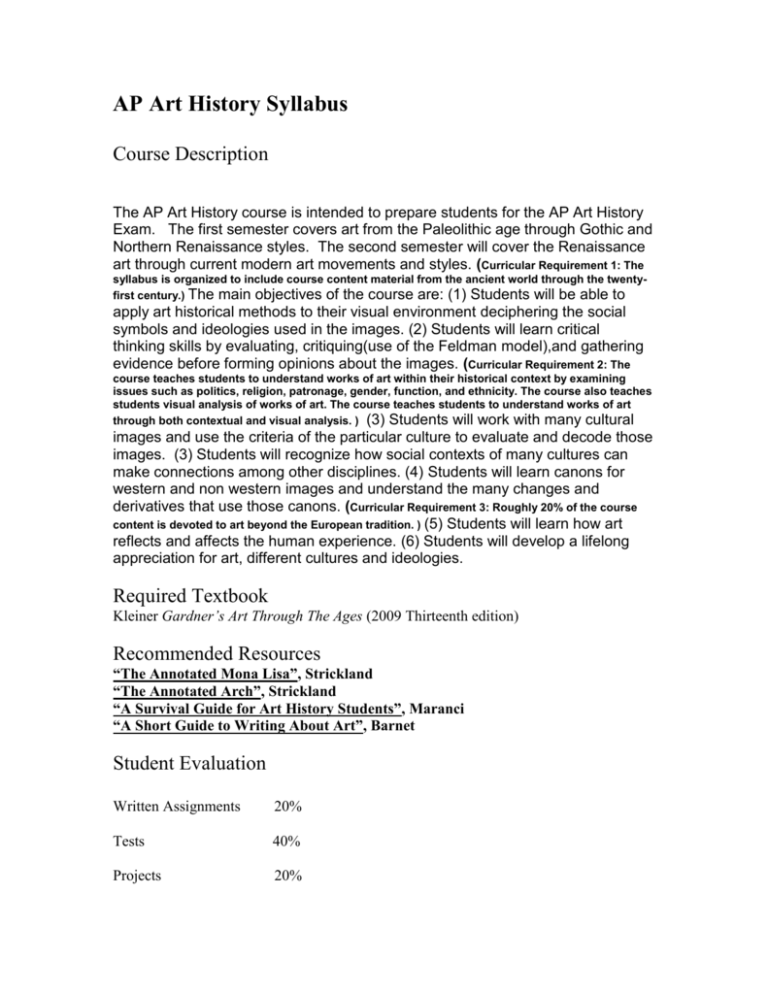
AP Art History Syllabus Course Description The AP Art History course is intended to prepare students for the AP Art History Exam. The first semester covers art from the Paleolithic age through Gothic and Northern Renaissance styles. The second semester will cover the Renaissance art through current modern art movements and styles. (Curricular Requirement 1: The syllabus is organized to include course content material from the ancient world through the twentyfirst century.) The main objectives of the course are: (1) Students will be able to apply art historical methods to their visual environment deciphering the social symbols and ideologies used in the images. (2) Students will learn critical thinking skills by evaluating, critiquing(use of the Feldman model),and gathering evidence before forming opinions about the images. (Curricular Requirement 2: The course teaches students to understand works of art within their historical context by examining issues such as politics, religion, patronage, gender, function, and ethnicity. The course also teaches students visual analysis of works of art. The course teaches students to understand works of art through both contextual and visual analysis. ) (3) Students will work with many cultural images and use the criteria of the particular culture to evaluate and decode those images. (3) Students will recognize how social contexts of many cultures can make connections among other disciplines. (4) Students will learn canons for western and non western images and understand the many changes and derivatives that use those canons. (Curricular Requirement 3: Roughly 20% of the course content is devoted to art beyond the European tradition. ) (5) Students will learn how art reflects and affects the human experience. (6) Students will develop a lifelong appreciation for art, different cultures and ideologies. Required Textbook Kleiner Gardner’s Art Through The Ages (2009 Thirteenth edition) Recommended Resources “The Annotated Mona Lisa”, Strickland “The Annotated Arch”, Strickland “A Survival Guide for Art History Students”, Maranci “A Short Guide to Writing About Art”, Barnet Student Evaluation Written Assignments 20% Tests 40% Projects 20% Daily participation 20% Written assignments: will be reading reviews, essay questions from past AP art history tests, altered book assignments where students use a page of the book to illustrate notes using collage, drawings, color; field trip essays and critiques of works of art (based on a possible trip to the Menil museum, Museum of Fine Art Houston, Printing museum, Orange show, Art Car museum (contemporary art), Row Houses Museum (contemporary installations), Diverse Works (contemporary artists studios), Contemporary Arts museum, an architectural tour of Houston) Curricular Requirement 1: The syllabus is organized to include course content material from the ancient world through the twenty-first century, slide review competitions ( class divides into groups and identifies and elaborates on previously seen slides). Curricular Requirement 2: The course teaches students to understand works of art within their historical context by examining issues such as politics, religion, patronage, gender, function, and ethnicity. The course also teaches students visual analysis of works of art. The course teaches students to understand works of art through both contextual and visual analysis Projects: could consist of an internet research, a power point presentation, a group project, a debate, a community outreach project, building a museum collection, a group video presentation on non-western tradition art, architecture, religion, gender orientation, and patronage. There will be three assignments throughout the year using the listed strategies for the presentation of a project. Curricular Requirement 3: Roughly 20% of the course content is devoted to art beyond the European tradition. Tests: mid-term and Semester final for each of the two semesters. There will be six week reviews and periodic slide reviews. Daily participation: is determined by the student’s classroom participation in discussions, attendance for tutorials, participation on field trips, turning assignments in on time, attending Saturday reviews (2) for the AP Art History test. Students will be responsible for turning in note cards for each period or style of art discussed using the provided images and format from the teacher. Tutorials: 2:30- 3:30 It is the student’s responsibility to inform the instructor when there is a conflict in testing schedules with other AP classes. The student may reschedule a test if there are more than three tests the same day. Saturday reviews: There will be two Saturdays set aside to review before the AP test. Students are expected to take advantage of at least one of the review days. Plagiarism: Students are expected to adhere to the district’s copy write and fair use guide lines. Copying or stealing the work of others for any reason is prohibited. Any plagiarism committed by a student will result in an F for the assignment and being referred to an assistant principal or advanced placement coordinator. Calendar: Approximate depending on school scheduling and unscheduled interruptions First 6 weeks Activities C1, C2 Introduction to Art History Feldman model for critiquing art Elements and principles of art Prehistory-Greek Hellenistic period Hammurabi’s Law Code Gods and Goddesses of Egypt Mummification and Immortality Building the great pyramids Greek Geometric and Orientalizing period through Hellenistic period Greek temple plans, Doric and Ionic orders Polykleitos’s cannon for the perfect statue Corinthian Capital C1—The syllabus is organized to include course content material from the ancient world through the twenty-first century. Curricular Requirement 2: The course teaches students to understand works of art within their historical context by examining issues such as politics, religion, patronage, gender, function, and ethnicity. The course also teaches students visual analysis of works of art. The course teaches students to understand works of art through both contextual and visual analysis. Assessment Strategies Reading assignment quizzes Altered book introduction and first assignment, book due every two weeks 5 minute and 30 minute written essays Discussions, oral questions Slide quiz Research assignment : Create a power point presentation comparing and contrasting how the space, art and symbols in a Buddhist or Hindu temple compare to the Greek temples we discussed in class. Due next 6 weeks. C3 Second 6 weeks Activities C1, C2, C3 Hellenistic Greece – Early Gothic Buddhism/Hinduism temple power points due Iconography of Hinduism and Buddhism Stupa Daoism and Confucianism Xie He’s six cannons Buddhist Japan Heian Court Culture Etruscan art- audacity of Etruscan Women Roman Republic to Late Empire Roman Concrete Construction Eyewitness account of the eruption of Mount Vesuvius Curricular Requirement 3: Roughly 20% of the course content is devoted to art beyond the European tradition. Roll playing in Roman portraiture . C1—The syllabus is Catacombs and funerary arts organized to include course content material Byzantium from the ancient world Pendentives and Squinches through the twenty-firs century. Theodora a most unusual Empress Icons and Iconoclasim Field trip to a museum Assignment for group project to be due next 6 weeks: Students will divide into groups And choose an art object from the museum from a non western culture. Each group will devise a presentation showing how the object reflected the culture, religion, values, politics, of the time it was produced. Assessment Strategies Notes illustrated and recorded in the altered book Reading assignment quizzes 5 minute written essays 1 thirty minute essay on museum trip Slide review contest Power point presentations due Third 6 weeks Activities C1, C2, C3 High Gothic – Northern Renaissance Islamic art Mohammed and Islam The mosque Africa prehistory to 1800’s Idealized Naturalism of Ile-Ife Christian art: Art of the War lords Carolingian art: Medieval books Medieval Monasteries and Benedictine rule France and Northern Spain Holy Roman Empire Italy, Normandy, England Pilgrimages and Cult of Relics The crusades Tapestries Gothic Europe Abbot Suger and Saint Denis Gothic Cathedral Italy 1200-1400 Artist’s Guilds, commissions, and Contracts Fresco painting Artistic training in Renaissance Italy Northern Europe 1400-1500 C2—The course teaches students to understand works of art within their historical context by examining issues such as politics, religion, patronage, gender, function, and ethnicity. The course also teaches students visual analysis of works of art. The course teaches students to understand works of art through both contextual and visual analysis. C3—Roughly 20 percent of the course content is devoted to art beyond the European tradition. (See the most recent AP Art History Course Description for further information.) Tempera and oil Panting . C1—The syllabus is organized to include Woodcuts, engravings, and etchings course content material Italy 1400-1500 from the ancient world through the twenty-firs Renaissance Perspectival systems century. Italian Princely Courts and Artistic Patronage Group projects due Assessment Strategies Semester final tests. Altered book assignment Reading assignment assessment 30 minute essay question; student groups will assess the questions using rubric from released AP tests. Fourth 6 weeks C2—The course teaches students to understand works of art within their historical context by examining issues such as politics, religion, patronage, gender, function, and ethnicity. The course also teaches students visual analysis of works of art. The course teaches students to understand works of art through both contextual and visual analysis. Activities C1, C2, Renaissance- Impressionism France 1500-1600 Italy, Mannerism Leonardo and Michelangelo: Painting versus Sculpture Religious art in counter-reformation Italy Women in the Renaissance art world Holy Roman empire, France, Spain Netherlands Catholic and Protestant views of Salvation Protestantism and Iconoclasm 1600-1700 Letters of Artemisia Gentileschi Velasquez and Philip lV C3—Roughly 20 Northern Europe percent Rubens on the consequences of War of the course content is devoted to art beyond Middle class patronage and the art market in the Dutch Republic the European tradition. India; Indian miniature painting (See the most recent AP Art History Course Field trip to a museum or architectural tour of the city of Houston Description for further Rothko chapel, Menil collection, Contemporary Arts Museum information.) Assessment Strategies 5 minute and 30 minute essays Slide review competition Altered book notes Research project : Students will research and present a project on one of the following topics, Zen Buddhism, Japanese modern art, Anime and its connections to historic Japanese art styles, Japanese Tea ceremony, Aztec religion and iconography, tattoo in Polynesia, iconography of North American Indian totem poles, choose a tribe or geographic area in Africa and illustrate and discuss their religious icons and symbols and how they may have influenced western culture. Reading assignment assessment Fifth 6 weeks C1—The syllabus is Activities C1, C2, C3 organized to include French and American Impressionism- Social Commentary Art course content material 1700-1900 from the ancient world through the twenty-firs West Africa century. Gender roles in African art production African Masquerades Rocco Enlightenment Neoclassicism Diderot on Chardin C2—The course teaches David on Greek style and public art students to understand works of art within their Romanticism historical context by Realism examining issues such as politics, religion, Architecture patronage, gender, Romantic spirit in Art, Music and literature function, and ethnicity. The course also teaches Daguerreotype, calotype, wet-plate photography students visual analysis Impressionism of works of art. The course teaches students Post Impressionism to understand works Symbolism of art through both contextual and visual Sculpture analysis. Academic Solons and Independent Art Exhibitions 19th Century Color Theory Japonisms Altered books Research due on Non Western tradition subject from last 6 weeks. Class discussion possible debate by teams on Classicism versus Romanticism. Assessment Strategies Test written and multiple choice questions from released AP Art History tests Altered books due Slide contest C3—Roughly 20 Sixth 6 weeks Activities C1, C2 Color field- Holograms-Complete art/video- Performance art America and Europe 1900-2000 Matisse on color Cubism-Picasso Avante-Garde-Gertrude and Leo Stein Armory show Degenerate art Futurists manifesto percent of the course content is devoted to art beyond the European tradition. (See the most recent AP Art History Course Description for further information.) Painting and Sculpture since 1945 Architecture and Site specific art Performance and conceptual art, New Materials Pop art Chuck Close on painting and Photography Judy Chicago the Dinner Party (Assignment) Donald Judd on Sculpture and Industrial Material Phillip Johnson on Post modern Architecture Environmental Art Installation art Performance art Review for AP Test Museum auction American Art Art History Exam Assessment Strategies Saturday review Judy Chicago Dinner party assignment due Altered book assessments, Course surveys
